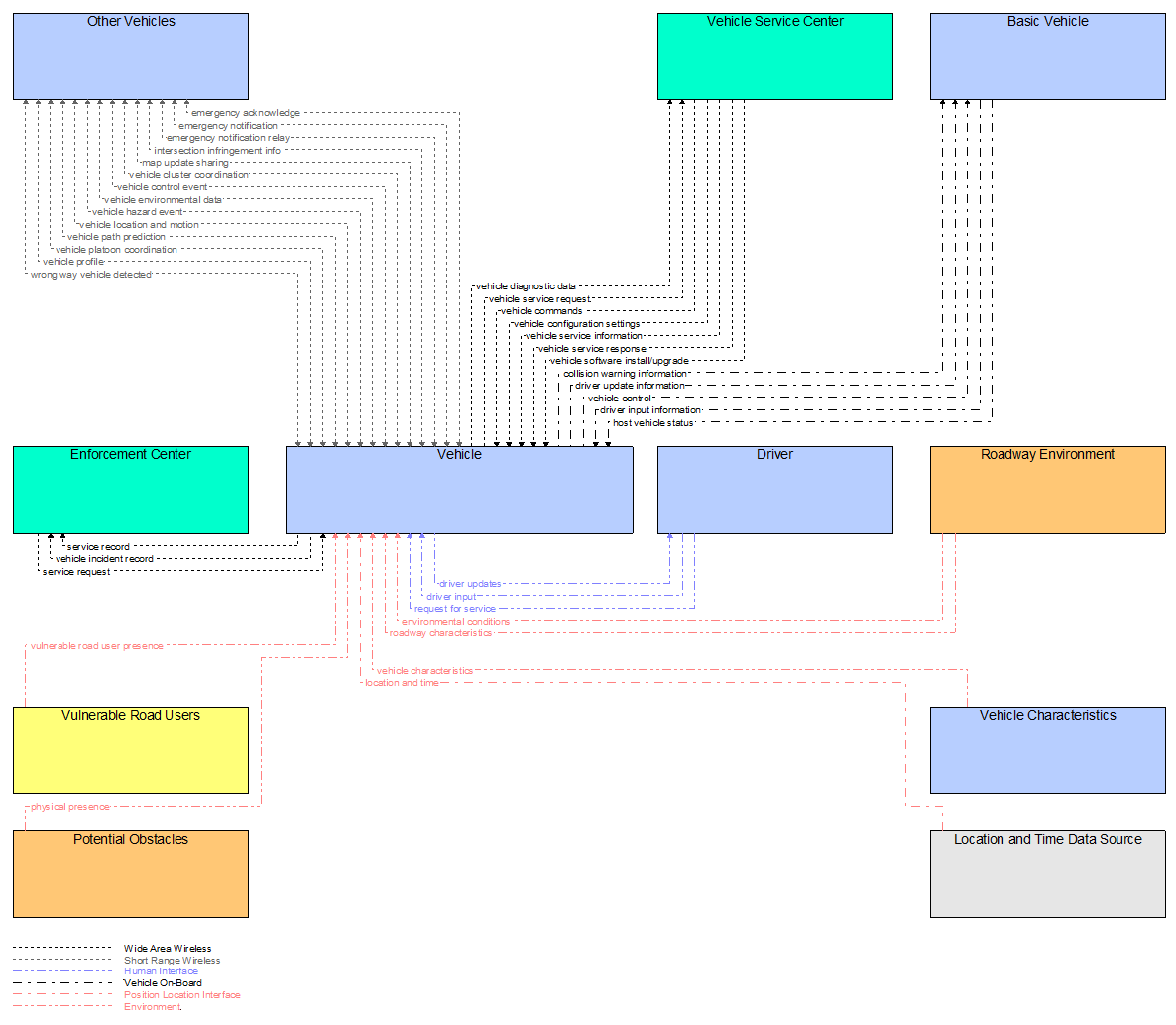Kind: Subsystem
Class: Vehicle
Type: System
Vehicle
Overview
This 'Vehicle' physical object is used to model core capabilities that are common to more than one type of Vehicle. It provides the vehicle-based general sensory, processing, storage, and communications functions that support efficient, safe, and convenient travel. Many of these capabilities (e.g., see the Vehicle Safety service packages) apply to all vehicle types including personal vehicles, commercial vehicles, emergency vehicles, transit vehicles, and maintenance vehicles. From this perspective, the Vehicle includes the common interfaces and functions that apply to all motorized vehicles. The radio(s) supporting V2V and V2I communications are a key component of the Vehicle. Both one-way and two-way communications options support a spectrum of information services from basic broadcast to advanced personalized information services. Advanced sensors, processors, enhanced driver interfaces, and actuators complement the driver information services so that, in addition to making informed mode and route selections, the driver travels these routes in a safer and more consistent manner. This physical object supports all six levels of driving automation as defined in SAE J3016. Initial collision avoidance functions provide 'vigilant co-pilot' driver warning capabilities. More advanced functions assume limited control of the vehicle to maintain lane position and safe headways. In the most advanced implementations, this Physical Object supports full automation of all aspects of the driving task, aided by communications with other vehicles in the vicinity and in coordination with supporting infrastructure subsystems.
This physical object is included in the following Service Packages:
- CVO10: Road Weather Information for Freight Carriers
- MC06: Work Zone Management
- MC07: Work Zone Safety Monitoring
- MC09: Infrastructure Monitoring
- MC10: Asset Tracking
- PM06: Loading Zone Management
- PS04: Mayday Notification
- PS05: Vehicle Emergency Response
- PS07: Incident Scene Safety Monitoring
- PS09: Transportation Infrastructure Protection
- PT10: Intermittent Bus Lanes
- PT12: Transit Vehicle at Station/Stop Warnings
- PT13: Vehicle Turning Right in Front of a Transit Vehicle
- ST01: Emissions Monitoring
- ST02: Eco-Traffic Signal Timing
- ST03: Eco-Traffic Metering
- ST04: Roadside Lighting
- ST07: Eco-Lanes Management
- ST08: Eco-Approach and Departure at Signalized Intersections
- ST09: Connected Eco-Driving
- ST10: Low Emissions Zone Management
- SU04: Map Management
- SU05: Location and Time
- SU06: Object Registration and Discovery
- SU12: Vehicle Maintenance
- SU15: Vulnerable Road User Device Transition Support
- TI01: Broadcast Traveler Information
- TI07: In-Vehicle Signage
- TM02: Vehicle-Based Traffic Surveillance
- TM04: Connected Vehicle Traffic Signal System
- TM14: Advanced Railroad Grade Crossing
- TM16: Reversible Lane Management
- TM17: Speed Warning and Enforcement
- TM21: Speed Harmonization
- TM22: Dynamic Lane Management and Shoulder Use
- TM24: Tunnel Management
- TM25: Wrong Way Vehicle Detection and Warning
- VS01: Autonomous Vehicle Safety Systems
- VS02: V2V Basic Safety
- VS03: Situational Awareness
- VS04: Special Vehicle Alert
- VS05: Curve Speed Warning
- VS06: Stop Sign Gap Assist
- VS07: Road Weather Motorist Alert and Warning
- VS08: Queue Warning
- VS09: Reduced Speed Zone Warning / Lane Closure
- VS10: Restricted Lane Warnings
- VS11: Oversize Vehicle Warning
- VS12: Vulnerable Road User Safety
- VS13: Intersection Safety Warning and Collision Avoidance
- VS14: Cooperative Adaptive Cruise Control
- VS15: Infrastructure Enhanced Cooperative Adaptive Cruise Control
- VS16: Maneuver Coordination
- VS17: Automated Vehicle Operations
- VS18: Management of Electronic Traffic Regulations (METR)
- WX01: Weather Data Collection
- WX03: Spot Weather Impact Warning
Functionality
Triples
Security
This physical object has the following security levels for the associated service packages.
This interfaces diagram had many interfaces and so was broken up into a Subsystem and Terminator interfaces diagram.
Subsystem Interfaces Diagram
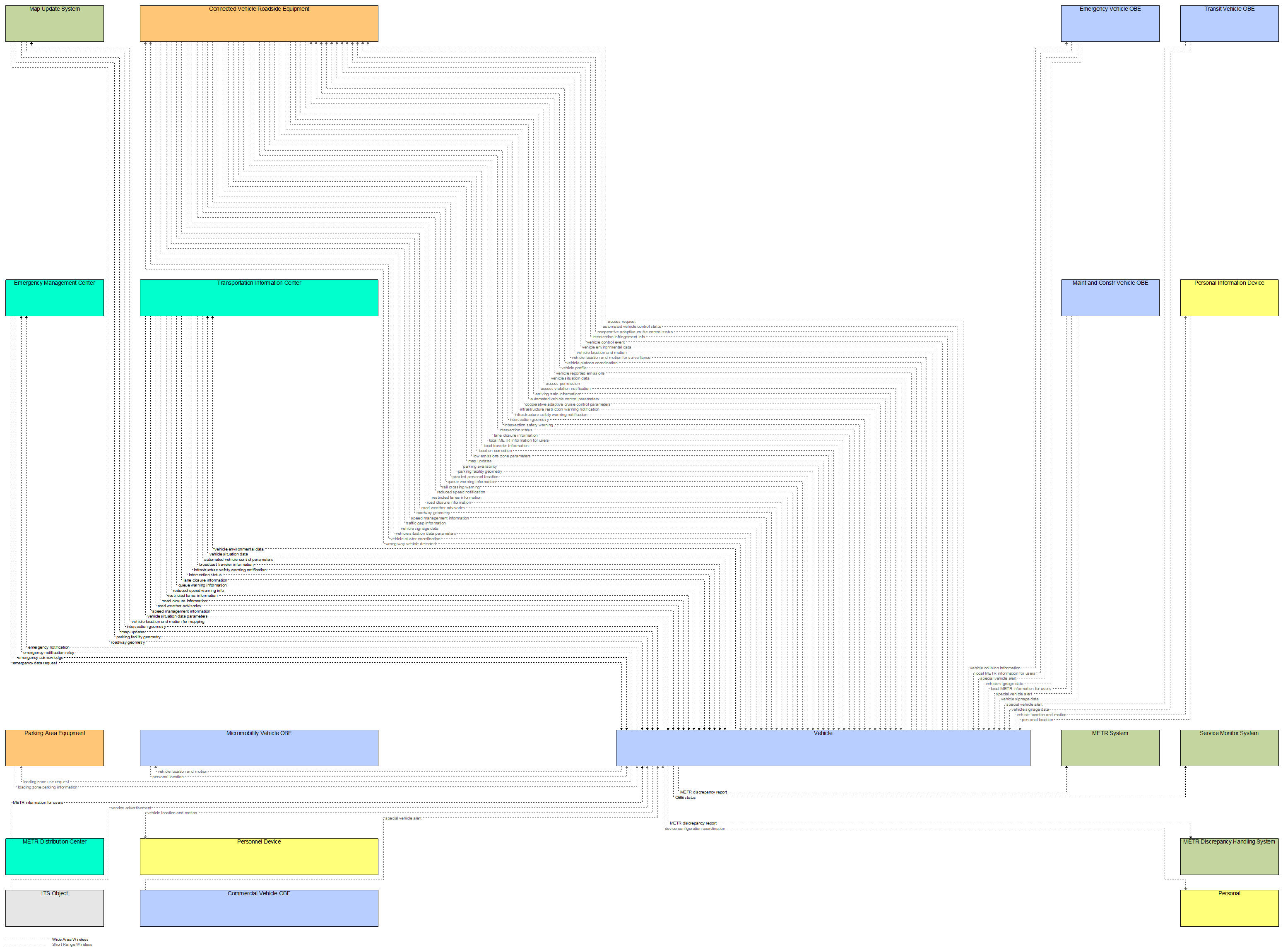
Standards
Currently, there are no standards associated with the physical object itself though the interfaces may have standards associated with them. For standards related to interfaces, see the specific information flow triple pages.
Alternative Configurations
Four different types of implementations are represented by the Vehicle On-Board Equipment. Four diagrams illustrate the four different implementations. Each diagram shows the subset of interfaces from ARC-IT that are relevant to that particular implementation. Note that a V2V safety application is shown, but the four implementation options also provide varied support for other vehicle safety applications. A fifth diagram covers a scenario where an aftermarket carry-in device is carried in to a vehicle that is already equipped with one of the Vehicle OBE implementations.
1. Vehicle Awareness Device – This is an aftermarket electronic device, installed in a vehicle without connection to vehicle systems, that is only capable of sending the basic safety message over short range communications. Vehicle awareness devices do not issue audible or visual warnings, alerts, or guidance to the driver of the vehicle.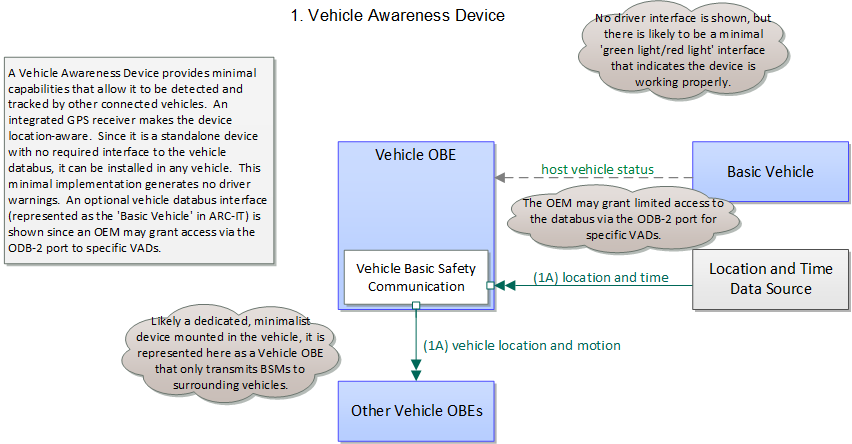
2. Aftermarket Device – This is an aftermarket electronic device, installed in a vehicle, and capable of sending and receiving messages over a wireless communications link. The self-contained device includes GPS, runs connected vehicle applications, and includes an integrated driver interface that issues audible or visual warnings, alerts, and guidance to the driver of the vehicle. The aftermarket device may or may not have access to some vehicle system status.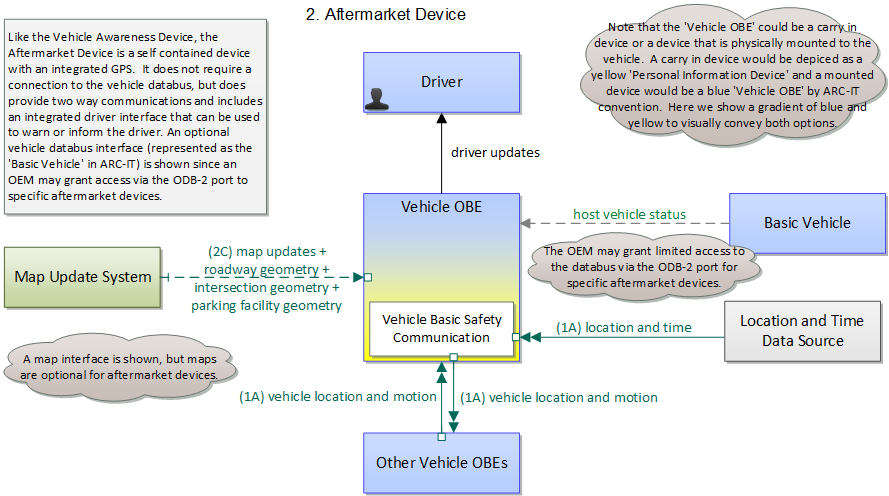
3. Retrofit Device – This is an OEM authorized electronic device installed in vehicles by an OEM authorized service provider, at a service facility after the vehicle has been built. This type of device provides two-way communications and is connected to a vehicle databus. Depending on implementation, the device may include an integrated driver interface and GPS or integrate with modules on the vehicle databus that provide these services. Depending on implementation, it may only support some of the vehicle safety applications identified in ARC-IT and potentially support additional applications that are not identified in ARC-IT.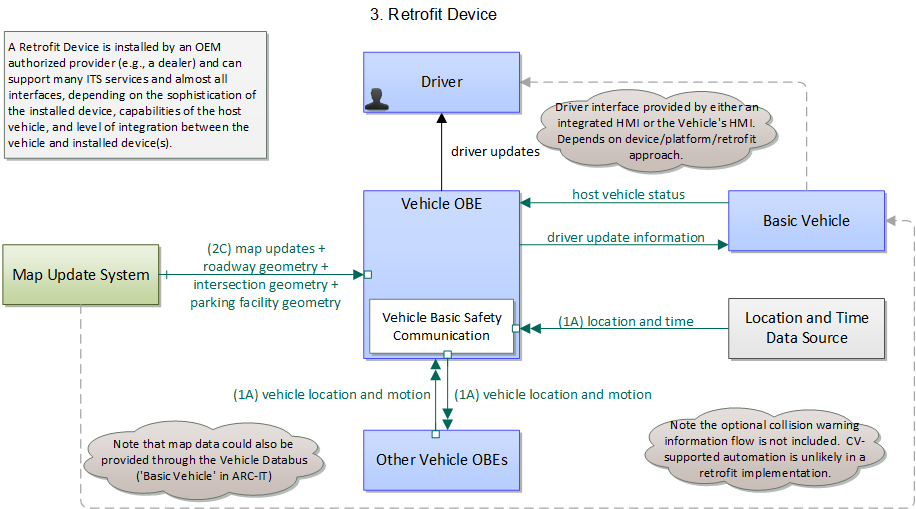
4. Integrated System – This is a system of one or more electronic devices integrated into vehicles during vehicle production. The Integrated System is connected to proprietary data busses to share information with other on-board systems. The Integrated System may be distributed across multiple subsystems and may be configured to support some of the vehicle safety applications identified in ARC-IT and potentially support additional applications that are not identified in ARC-IT.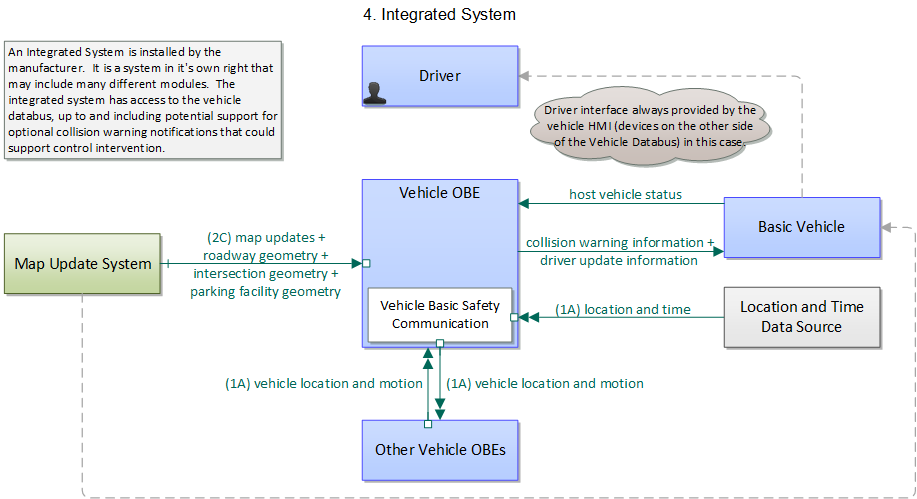
In retrofit and integrated implementations, the Vehicle OBE interfaces to other on-board systems through a vehicle databus (e.g., CAN). Represented in ARC-IT as the 'Vehicle', this interface provides access to on-board sensors, monitoring and control systems, and information systems that support connected vehicle applications. The vehicle databus may also be the source for GPS location and time, map data that supports vehicle safety applications, and the access point for the vehicle's driver-vehicle interface.
5. A fifth diagram covers a scenario where an aftermarket carry-in device is carried in to a vehicle that is already equipped with one of the Vehicle OBE implementations. In this scenario, we have two different devices with possibly two different radios and two different user interfaces that must be coordinated to avoid interference or conflicts.
